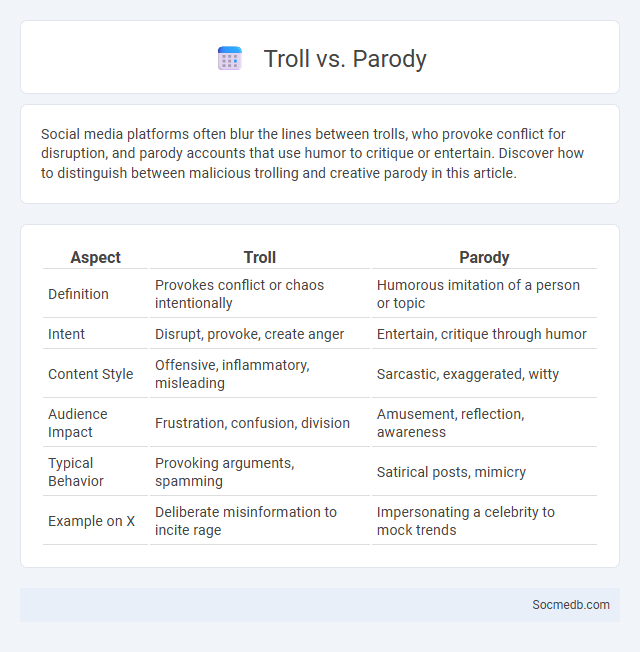
Photo illustration: Troll vs Parody
Social media platforms often blur the lines between trolls, who provoke conflict for disruption, and parody accounts that use humor to critique or entertain. Discover how to distinguish between malicious trolling and creative parody in this article.
Table of Comparison
| Aspect | Troll | Parody |
|---|---|---|
| Definition | Provokes conflict or chaos intentionally | Humorous imitation of a person or topic |
| Intent | Disrupt, provoke, create anger | Entertain, critique through humor |
| Content Style | Offensive, inflammatory, misleading | Sarcastic, exaggerated, witty |
| Audience Impact | Frustration, confusion, division | Amusement, reflection, awareness |
| Typical Behavior | Provoking arguments, spamming | Satirical posts, mimicry |
| Example on X | Deliberate misinformation to incite rage | Impersonating a celebrity to mock trends |
Understanding Trolls: Definition and Origins
Trolls are individuals who deliberately provoke or disrupt online conversations by posting inflammatory, off-topic, or offensive messages. Originating from early internet forums and chat rooms, trolling behavior can be traced back to the 1980s, evolving with social media platforms into a widespread phenomenon. Understanding trolls helps you recognize their tactics and mitigate their impact on your digital interactions.
What is Parody? Key Characteristics
Parody in social media is a creative content form that humorously imitates or exaggerates existing posts, trends, or personalities to entertain or critique. Key characteristics include recognizable references, exaggeration of distinctive features, and a clear intent to provoke laughter or reflection without malicious intent. Understanding these elements helps you create engaging and shareable parody content that resonates with your audience.
Troll vs Parody: Core Differences
Trolls on social media deliberately provoke and harass users to elicit emotional reactions, often spreading misinformation and creating hostile environments. Parody accounts or content mimic real profiles or events for humor and satire, aiming to entertain rather than cause harm. Understanding these core differences helps platforms enforce appropriate moderation policies and maintain user engagement without stifling creative expression.
The Motivation Behind Trolling
Trolling on social media often stems from a desire to seek attention and provoke emotional reactions from others, fueling the troll's sense of power and control. You may encounter trolls targeting specific individuals or groups to disrupt conversations and create chaos for entertainment or personal satisfaction. Understanding this motivation helps to develop strategies for maintaining a positive online environment and minimizing the impact of harmful behavior.
The Purpose and Appeal of Parody
Parody on social media serves as a powerful tool for satire, allowing users to critique cultural norms, political figures, and popular trends through humor and exaggeration. Its appeal lies in relatability and entertainment value, often engaging audiences by providing a fresh perspective that challenges conventional narratives. By leveraging familiar content in creative ways, parody fosters community interaction and amplifies viral potential across platforms like Twitter, Instagram, and TikTok.
Identifying a Troll: Common Tactics
Trolls on social media often use inflammatory language, personal attacks, and divisive topics to provoke emotional reactions and disrupt conversations. They frequently post off-topic comments, exaggerate claims, and employ sarcasm or insults to derail discussions. Recognizing repetitive negative behavior and consistent attempts to provoke without constructive dialogue are key indicators of trolling tactics.
Recognizing Parody: Typical Signs
Recognizing parody on social media involves spotting exaggerated content, absurd scenarios, and humorous tones that mimic real-life events or figures. You can identify typical signs such as intentionally misspelled names, improbable claims, and satirical hashtags designed to entertain rather than inform. Being aware of these markers helps you avoid misinformation and appreciate creative content without confusion.
The Impact of Trolling vs Parody Online
Trolling generates negative social media interactions by spreading misinformation, harassment, and emotional distress, often disrupting constructive online communication. Parody, in contrast, employs satire and humor to critique societal issues and public figures, fostering engagement and critical thinking while avoiding harmful intent. Understanding these distinct impacts helps platforms develop better moderation strategies to balance free expression and community well-being.
Legal and Ethical Considerations
Navigating legal and ethical considerations on social media involves understanding privacy laws, intellectual property rights, and content regulations to avoid legal repercussions. Your responsibility includes respecting user consent, avoiding misinformation, and adhering to platform policies to maintain ethical standards. Compliance with the General Data Protection Regulation (GDPR) and the Digital Millennium Copyright Act (DMCA) is essential for lawful and ethical social media engagement.
Navigating Internet Culture: Choosing Humor Over Harm
Navigating internet culture requires understanding the impact of social media on communication, emphasizing humor that fosters connection rather than harm. Platforms like Twitter, TikTok, and Instagram shape online interactions where positive engagement encourages community building and mental well-being. Prioritizing respectful humor reduces cyberbullying and promotes a healthier digital environment.
 socmedb.com
socmedb.com